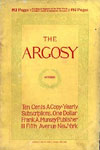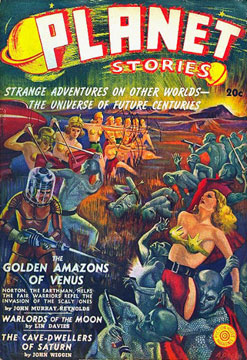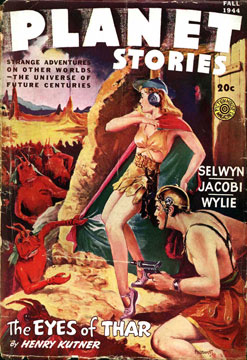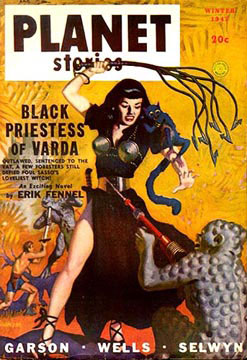Planet Stories
In the early 1940s, science fiction pulp magazines began to place a renewed importance on scientific extrapolation and social commentary in their stories. Many readers desired a return to the fantastic worlds and the interplanetary adventures that, in large part, had defined scientific romances of the previous decades, however, and this desire was answered, in the winter of 1939, with the premiere issue of Planet Stories.
Planet Stories was published by Fiction House, a company that, with titles that included Action Stories (1921) and Wings (1928), already held some ground in the pulp arena, under the guidance of publisher Thurman T. Scott. Fiction House went dormant for several years at the height of the Great Depression, but it resumed activity in 1934. Following this rebound, the company sought not only to reestablish itself in the pulp market, but also to stake out a claim in the burgeoning comic book field. Thus, Planet Stories was launched alongside Planet Comics, just as Fiction House pulps Jungle Stories (1938) and Fight Stories (1928) later spawned Jungle Comics and Fight Comics, respectively.
Planet Stories' first (and throughout most of the title's run, senior) editor was Malcolm Reiss. With the help of assistant Julius Schwartz (best-known for his own sf writings, and his role in the birth of comics' Silver Age at DC Comics), Reiss presented stories that, while science fiction in genre, played to an audience mostly interested in interplanetary escapism and exotic alien worlds, rather than any die-hard dedication to scientific prophecy. This is not to say that Planet Stories did not offer "real sf" to its readers. Many great authors of the genre – past, present and future – contributed to its pages.
Early on, Planet Stories' illustrations were provided by sf art legend Frank R. Paul, who had defined much of the genre's appearance and feel during the 1920s in the pages of the first sf magazine, Hugo Gernsback's Amazing Stories; shortly after its debut, artists such as Hannes Bok, Kelly Freas, and Alexander Leydenfrost helped Planet Stories forge an identity all its own.
Literary works by Ray Cummings, Clifford Simak, Theodore Sturgeon, and other veterans also appeared, as did early works by Leigh Brackett, Isaac Asimov, Ray Bradbury and Poul Anderson. Throughout the 1940s and early 50s, seventeen stories by Brackett appeared first in Planet, along with two of the components that would later be collected in Bradbury's The Martian Chronicles; Philip K. Dick's first professionally-published work appeared in Planet Stories in the summer of 1952. The magazine's letter column, titled "The Vizigraph," provided an international forum for discussion, criticism, and correspondence nearly as important to the formation of early sf fandom as any of those in the earlier Gernsback titles.
Planet Stories was published on a quarterly basis for most of its existence, with a brief bi-monthly experiment in 1943 (which was cut short by wartime paper shortages), and again from January of 1951 to May of 1954. Back to its original quarterly publication schedule, Planet Stories lasted longer than many other pulp titles, which by then had transformed into either men's mags or "slick magazines;" simply disappeared; or, in the case of sf titles such as Astounding Stories, had transitioned into smaller, digest-sized formats. In the summer of 1955, Planet Stories ended, with 71 issues to its name.
Nathan Vernon Madison, Virginia Commonwealth University
Works Consulted
Ashley, Michael, ed. The History of the Science Fiction Magazine – Vol. 1: 1926-1935 (Chicago: Henry Regnery Company, 1976).
_____________. The Time Machines: The Story of the Science-Fiction Pulp Magazines from the Beginning to 1950 (Liverpool: Liverpool University Press, 2000).
Gunn, James. Alternate Worlds: The Illustrated History of Science Fiction (Englewood Cliffs: A&W Visual Library/Prentice Hall, 1975).
Tymn, Marshall B. and Mike Ashley, eds. Science Fiction, Fantasy and Weird Fiction Magazines (Westport: Greenwood Press, 1985).





